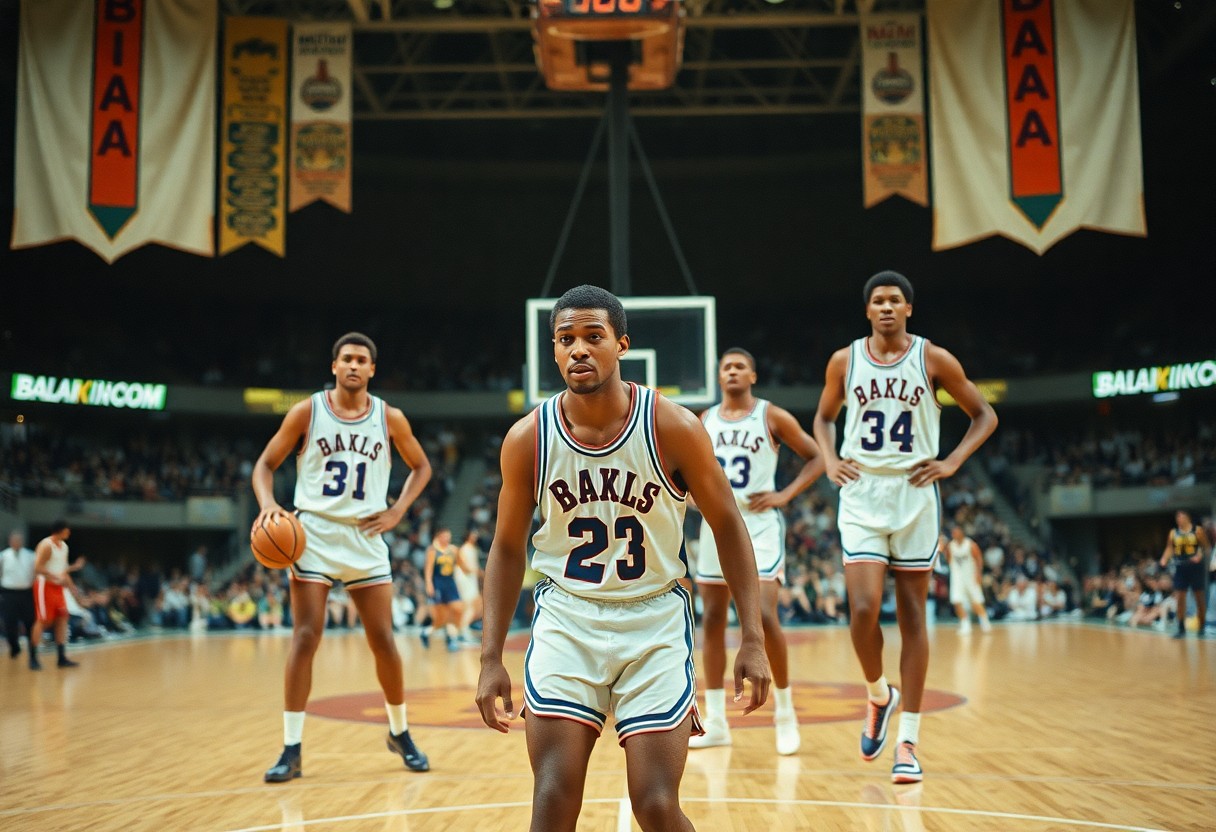Players in the American Basketball Association (ABA) have made lasting impacts on the sport, showcasing extraordinary talent and unforgettable moments on the court. If you want to probe the legacy of the ABA, you’ll discover legends like Julius Erving, who redefined athleticism, and George Gervin, known for his artistry in scoring. This post will guide you through the greatest players in ABA history, providing insights into their careers and contributions that continue to inspire basketball fans and players alike.
Origins of the ABA
To understand the impact of the American Basketball Association (ABA), you must explore its origins during the early 1960s. This league arose as an answer to the growing need for a professional basketball alternative to the National Basketball Association (NBA), providing additional opportunities for players, teams, and fans alike. With its vibrant spirit and innovative approach, the ABA quickly distinguished itself, paving the way for a revolutionary era in professional basketball.
The Formation of the League
An ambitious group of owners and entrepreneurs founded the ABA in June 1967, intending to offer a new model for professional basketball. This league aimed to challenge the traditional norms of the NBA, promoting a more dynamic and fan-focused experience. They created a vision for a league that emphasized showmanship and creativity on the court, which attracted attention and interest from players and fans across the country.
Notable Early Teams
Notable early teams in the ABA included the Indiana Pacers, Kentucky Colonels, and New Jersey Americans, each contributing to the league’s identity and culture. These franchises not only showcased exceptional talent but also demonstrated innovative marketing strategies and community engagement that helped to solidify their status within the league.
Further illustrating the ABA’s diversity, these teams often featured unique playing styles and colored their respective cities’ basketball scenes. The Indiana Pacers, for instance, became known for their incredible teamwork and strategic plays, while the Kentucky Colonels showcased individual talent, attracting marquee players to their ranks. Each team’s efforts helped to establish the ABA as a formidable competitor to the NBA, laying the groundwork for the league’s long-lasting legacy in basketball history.
Pioneering Players
If you’re exploring the roots of professional basketball, the ABA’s pioneering players are important to understanding the evolution of the game. These athletes pushed boundaries, introducing a flair and creativity that broadened the playing style and captivated fans. Their contributions laid the groundwork for future leagues, transforming basketball into the dynamic sport you know today. From exciting dunks to innovative plays, these trailblazers set the stage for what would become modern basketball.
The Impact of Dr. J
Any discussion of basketball’s history would be incomplete without acknowledging Dr. J, also known as Julius Erving. His revolutionary style of play brought a whole new level of excitement to the game, blending athleticism with artistry. Dr. J not only elevated the profile of the ABA but also changed the way players approached the sport, inspiring a generation that followed.
Dominance of George Gervin
Below the surface of the ABA’s rich history lies the dominance of George Gervin, a player whose scoring abilities transformed the league. Gervin’s signature finger roll and exceptional shooting accuracy captivated fans and created a standard for offensive excellence that players strive for even today.
Considering Gervin’s unmatched skills, you can see why he remains a pivotal figure in basketball history. With multiple scoring titles and an effortless style, he established himself as one of the most prolific scorers in the ABA. His contributions played a significant role in raising the league’s status and showcasing the talent that the ABA harnessed. When you think of basketball greatness, Gervin’s legacy as a scorer is often at the forefront, leaving an indelible mark on both the ABA and the sport as a whole.
The Rise of the Big Men
Now, as the ABA evolved, it became evident that towering athletes were dominating the game. The rise of big men like Kareem Abdul-Jabbar and Artis Gilmore changed the dynamics of basketball, making height and agility key assets on the court. Their ability to score, defend, and rebound reshaped offensive strategies, paving the way for the modern game you see today. Understanding this era is vital for appreciating how these players contributed to the sport’s evolution.
Kareem Abdul-Jabbar’s Influence
Abdul-Jabbar’s presence in the ABA significantly impacted the league. Known for his skyhook shot and exceptional skill set, he set a new standard for big men, combining size with finesse. His influence extended beyond scoring; it redefined how teams utilized tall players, influencing the strategies you watch in today’s game.
Artis Gilmore’s Legacy
Along with Abdul-Jabbar, Artis Gilmore left an indelible mark on the ABA. His impressive combination of strength, agility, and skill made him a formidable force on both ends of the floor. Gilmore was not only a two-time ABA MVP but also led the league in both scoring and rebounding, showcasing the importance of big men in the game.
Even after his career, Gilmore’s legacy continues to be felt in the basketball world. His performance brought attention to the potential of big men, inspiring future generations of players to harness both size and skill. You can see his influence in the way modern big men play today, blending speed with power to dominate the court. By understanding Gilmore’s contributions, you can appreciate the evolution of the game and the pivotal role played by giants in basketball history.
Revolutionary Playing Styles
For basketball enthusiasts, the ABA era introduced game styles that changed how you perceive play on the court. Players showcased extraordinary creativity, emphasizing flair and athleticism. This movement led to a more dynamic approach to scoring and strategy, forever altering the landscape of professional basketball.
The Fast-Paced Game
Beside traditional methods, the ABA’s fast-paced game elevated excitement and spectator engagement. Teams adopted a high-tempo approach, featuring quick ball movement and rapid transitions that kept defenses on their toes. This energetic style encouraged players to push their limits, making each game a thrilling spectacle for fans.
Three-Point Line Innovation
After the ABA introduced the three-point line, you witnessed an explosion of long-range shooting that reshaped offensive strategies. This innovation opened up the court and created opportunities for shooters to score beyond the arc, adding a new dimension to the game.
Plus, the three-point line not only transformed how you view scoring but also influenced coaching strategies and player development significantly. Coaches began to prioritize perimeter shooting, honing players’ long-range skills to enhance offensive flexibility. Stars like Rick Barry and George Gervin thrived in this environment, inspiring future generations to embrace outside shooting as a vital component of their game. The ABA’s pioneering spirit continues to resonate in today’s basketball, where the three-point shot has become integral to many teams’ successes.
ABA vs. NBA: A Rivalry
Many fans and players alike found themselves captivated by the intense rivalry between the ABA and NBA. During the late 1960s and early 1970s, both leagues competed fiercely for talent, fans, and media attention, creating a unique landscape in professional basketball. This competition pushed the boundaries of the game, leading to innovations like the three-point line and slam dunk contests that are now staples in basketball culture.
Key Moments in Competition
Rivalry fueled remarkable events, such as the dramatic championship matchups between the Indiana Pacers and the New York Nets. These high-stakes games showcased top talent and breathtaking performances, drawing in crowds eager to witness the showdown between the two leagues. Iconic players emerged from this rivalry, embodying the spirit and competition that defined both the ABA and NBA.
Merging with the NBA
About four years after the ABA ceased operations, the merging of the ABA with the NBA transformed the landscape of professional basketball. This historic union brought together four ABA teams into the NBA, leading to an influx of talent that would shape the future of the game.
The merger not only expanded the NBA but also allowed for the infusion of exciting playing styles and standout players from the ABA, enhancing the overall experience for fans. This collaboration helped to solidify traditions such as the three-point shot and the fast-paced game we see today. As a result, the league became a richer, more diverse environment, drawing in a broader audience and paving the way for the modern era of basketball.
Lasting Impact on Basketball
Unlike other leagues, the ABA introduced innovations that reshaped basketball as you know it today. With the introduction of the three-point line and the fast-paced style of play, the ABA set foundational elements that became hallmarks of modern basketball. The influence of the ABA’s creativity and flair can still be seen in the current game, affecting not only how it is played but also how it’s marketed and consumed by fans worldwide.
Contributions to Current Strategies
Along with its innovations, the ABA’s emphasis on athleticism and skill laid the groundwork for current strategies in basketball. The league’s focus on individual talent encouraged a more dynamic and entertaining style of play that is prevalent in the NBA today. You can see elements of this approach in the rise of perimeter shooting and smaller lineups, which have become necessary tactics in winning games.
Influence on Future Generations
Current players and coaches still draw inspiration from the ABA’s legacy, which continues to shape the future of basketball. The league’s spirit of innovation fosters new ideas that push the game’s boundaries, ensuring that the essence of the ABA lives on in every dunk, three-pointer, and fast break.
For instance, many current stars model their games after iconic ABA players, adopting their flair and playing style. Coaches incorporate strategies inspired by the league’s visionaries, encouraging a level of creativity that resonates with young athletes. By embracing this legacy, you witness how the ABA’s influence continues to inspire future generations, shaping the way basketball is played and perceived around the globe.
Final Words
Summing up, exploring the greatest basketball players in ABA history not only enriches your understanding of the game’s evolution but also highlights the incredible talent and dynamic play that defined this unique league. From Julius Erving to George Gervin, each player’s contributions have left an indelible mark on basketball, shaping the modern era in ways you may find surprising. As you explore into their stories and achievements, you gain a deeper appreciation for the artistry and athleticism that the ABA brought to the sport.

